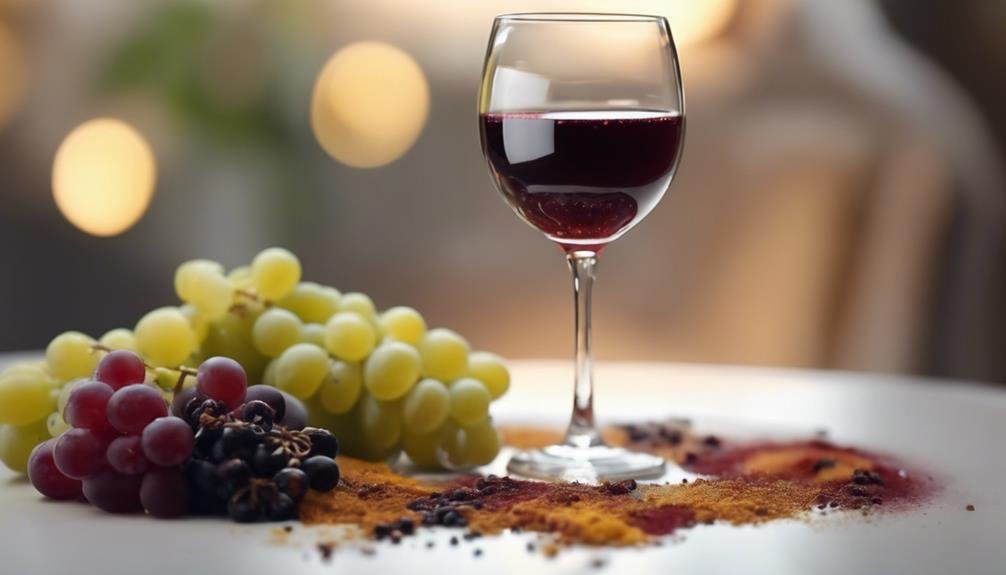To master wine tasting, focus on enhancing aroma perception by identifying scents that reveal details about the wine. Develop a discerning palate to evaluate taste elements like sweetness, acidity, and tannins for a balanced experience. Understanding components such as acidity and tannins will deepen your appreciation for wine complexity. Revealing wine tasting mastery lies in exploring aromas, tastes, and components that shape each wine's character. Sharpening these skills opens pathways to unravel the intricate world of wines.
Enhancing Aroma Perception
Improving Aroma Perception plays an essential role in mastering the art of wine tasting. It allows for a deeper exploration of the nuances and complexities present in a wine's bouquet. Aroma differentiation involves identifying the various scents that contribute to a wine's overall profile, enhancing sensory exploration.
Through this process, one can detect primary, secondary, and tertiary aromas, unraveling the layers of scent that reveal grape variety, aging, and origin. Sensory exploration also aids in flavor detection, as scent identification guides the taster in pinpointing specific notes within the wine.
Mastering Taste Analysis
Developing a discerning palate is essential in mastering the art of taste analysis during wine tasting sessions.
Balance evaluation is vital when gauging the interplay of sweetness, acidity, tannins, and alcohol levels in a wine. This involves understanding how these elements harmonize to create a well-rounded and enjoyable tasting experience.
Flavor comparison allows you to differentiate between different wines based on their unique taste profiles. By comparing the flavors of various wines, you can train your palate to identify specific characteristics and nuances in each glass.
Through consistent practice and thoughtful analysis, you can enhance your ability to appreciate the complexity and depth of flavors present in different wines, ultimately improving your overall wine tasting skills.
Understanding Wine Components

Exploring the intricate components of wine is essential for enhancing one's understanding of its complexity and character. Acidity balance plays a vital role in defining a wine's overall taste profile. The right balance of acidity can provide an invigorating zing or a more rounded flavor.
Tannin structure, on the other hand, contributes to the wine's texture and aging potential. It is responsible for the dry, puckering sensation in red wines and adds complexity to the overall taste experience.
Frequently Asked Questions
How Does Wine Aging Impact Its Aroma and Taste?
Wine aging transforms a wine's aroma and taste through bottle storage, where controlled oxygen exposure influences chemical reactions. Oxygen softens tannins, integrates flavors, and enhances complexity. Over time, aged wines develop nuanced aromas and smoother textures, offering a unique tasting experience.
Can Different Glass Shapes Affect Wine Tasting Experience?
Different glass shapes can affect the wine tasting experience. Glass selection influences sensory perception, highlighting aromas and taste nuances. Understanding how shape impacts airflow and aroma concentration enhances the enjoyment and appreciation of wine during tastings.
What Is the Significance of Swirling Wine in a Glass?
Swirling wine in a glass is an essential tasting technique. By swirling, you aerate the wine, releasing aromas that enhance the tasting experience. This action helps to reveal the full potential of the wine's bouquet, allowing for a more nuanced sensory exploration.
Does Decanting Wine Really Make a Difference in Taste?
Decanting wine can enhance its taste by separating sediments, promoting aeration, and allowing flavors to evolve. Addressing decanting myths, the process can reveal complex aromas and soften harsh tannins, ultimately improving the overall tasting experience.
How Does Serving Temperature Affect Wine Flavor Profile?
Temperature control plays an essential role in wine tasting, influencing flavor nuances significantly. Serving wine at the correct temperature enhances its aroma, taste, and overall profile. Understanding how temperature impacts wine allows for a more enjoyable and insightful tasting experience.
Conclusion
To wrap up, refining your wine tasting skills can lead to a deeper appreciation of the complexities of each bottle.
Did you know that there are over 10,000 different grape varieties used in winemaking worldwide?
By grasping the nuances of aroma, taste, and wine components, you can discover the secrets of wine tasting mastery and set off on a journey of sensory exploration.
Cheers to expanding your palate and uncovering the world of wine!
